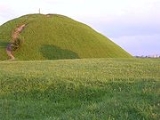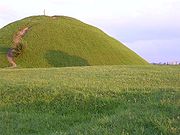
Krakus Mound
Encyclopedia

Tumulus
A tumulus is a mound of earth and stones raised over a grave or graves. Tumuli are also known as barrows, burial mounds, Hügelgrab or kurgans, and can be found throughout much of the world. A tumulus composed largely or entirely of stones is usually referred to as a cairn...
located in the Podgórze
Podgórze
Podgórze is a district of Kraków, Poland, situated on the right bank of the Vistula River. Initially a village at the foot of Lasota Hill was granted city status by the Austrian Emperor Joseph II in 1784 and has become Royal Free City of Podgorze...
district
Districts of Kraków
The city of Kraków is divided into 18 administrative districts, each with a degree of autonomy within the municipal government. The Polish name for such a district is dzielnica....
of Kraków
Kraków
Kraków also Krakow, or Cracow , is the second largest and one of the oldest cities in Poland. Situated on the Vistula River in the Lesser Poland region, the city dates back to the 7th century. Kraków has traditionally been one of the leading centres of Polish academic, cultural, and artistic life...
, Poland
Poland
Poland , officially the Republic of Poland , is a country in Central Europe bordered by Germany to the west; the Czech Republic and Slovakia to the south; Ukraine, Belarus and Lithuania to the east; and the Baltic Sea and Kaliningrad Oblast, a Russian exclave, to the north...
; assumed to be the resting place of the legendary prince Krakus
Krakus
Krakus, Krak or Grakch was a legendary Polish prince and founder of Kraków, the ruler of the tribe of Lechitians . Krakus is also credited with building Wawel Castle. The first recorded mention of Krakus, then spelled Grakch, is in the Chronica seu originale regum et principum Poloniae from 1190...
. It is located on Lasota Hill, approximately 3 kilometres (2 mi) south of the city centre, at an altitude of 271 metres (889 ft), with the base diameter of 60 metres (197 ft) and the height of 16 metres (52 ft).
The age and the original purpose of the mound remain a mystery. Excavations conducted in mid-1930s revealed that the mound consists of a solid wooden core covered with soil and turf. Some artifacts dating from between the 8th and 10th centuries were found inside, but no human remains were discovered. According to another hypothesis the mound is of Celtic origin and dates from the 2nd-1st century BCE.
For many years until mid-1830s a folk festival
Festival
A festival or gala is an event, usually and ordinarily staged by a local community, which centers on and celebrates some unique aspect of that community and the Festival....
was held annually on the first Tuesday after Easter
Easter
Easter is the central feast in the Christian liturgical year. According to the Canonical gospels, Jesus rose from the dead on the third day after his crucifixion. His resurrection is celebrated on Easter Day or Easter Sunday...
on the slopes of the Krakus Mound.
See also
- Wanda MoundWanda MoundWanda Mound is a tumulus located in Mogiła in Kraków, Poland. The mound is assumed to be the resting place of the legendary princess Wanda. According to one version of the story, she committed suicide by drowning in the Vistula river to avoid unwanted marriage...
, legendary grave of Krakus' daughter - Kościuszko MoundKosciuszko MoundKościuszko Mound in Kraków, Poland, erected by Cracovians in commemoration of the Polish national leader Tadeusz Kościuszko, is an artificial mound modeled after Kraków's prehistoric mounds of Krak and Wanda. A serpentine path leads to the top, approx. above sea level, with a panoramic view of...
in Kraków - Piłsudski Mound, Kraków

